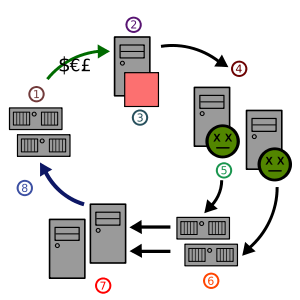Zombie (computer science)
In computer science, a zombie is a computer connected to the Internet that has been compromised by a hacker, computer virus or trojan horse program and can be used to perform malicious tasks of one sort or another under remote direction. Botnets of zombie computers are often used to spread e-mail spam and launch denial-of-service attacks (DOS attacks). Most owners of "zombie" computers are unaware that their system is being used in this way. Because the owner tends to be unaware, these computers are metaphorically compared to fictional zombies. A coordinated DDoS attack by multiple botnet machines also resembles a "zombie horde attack", as depicted in fictional zombie films.

Advertising
Zombie computers have been used extensively to send e-mail spam; as of 2005, an estimated 50–80% of all spam worldwide was sent by zombie computers.[1] This allows spammers to avoid detection and presumably reduces their bandwidth costs, since the owners of zombies pay for their own bandwidth. This spam also greatly furthers the spread of Trojan horses, as Trojans are not self-replicating. They rely on the movement of e-mails or spam to grow, whereas worms can spread by other means.[2] For similar reasons zombies are also used to commit click fraud against sites displaying pay per click advertising. Others can host phishing or money mule recruiting websites.
Distributed denial-of-service attacks
Zombies can be used to conduct distributed denial-of-service (DDOS) attacks, a term which refers to the orchestrated flooding of target websites by large numbers of computers at once. The large number of Internet users making simultaneous requests of a website's server is intended to result in crashing and the prevention of legitimate users from accessing the site.[3] A variant of this type of flooding is known as distributed degradation-of-service. Committed by "pulsing" zombies, distributed degradation-of-service is the moderated and periodical flooding of websites, done with the intent of slowing down rather than crashing a victim site. The effectiveness of this tactic springs from the fact that intense flooding can be quickly detected and remedied, but pulsing zombie attacks and the resulting slow-down in website access can go unnoticed for months and even years.[4] Notable incidents of distributed denial- and degradation-of-service attacks in past include the attack upon the SPEWS service in 2003, and the one against Blue Frog service in 2006. In 2000, several prominent Web sites (Yahoo, eBay, etc.) were clogged to a standstill by a distributed denial of service attack mounted by ‘MafiaBoy’, a Canadian teenager. An attack on grc.com is discussed at length, and the perpetrator, a 13-year-old probably from Kenosha, Wisconsin, was identified on the Gibson Research Web site. Steve Gibson disassembled a 'bot' which was a zombie used in the attack, and traced it to its distributor. In his account about his research, he describes the operation of a 'bot'-controlling IRC channel.[5]
Smartphones
Beginning in July 2009, similar botnet capabilities have also emerged for the growing smartphone market. Examples include the July 2009 in the "wild" release of the Sexy Space text message worm, the world's first botnet capable SMS worm, which targeted the Symbian operating system in Nokia smartphones. Later that month, researcher Charlie Miller revealed a proof of concept text message worm for the iPhone at Black Hat Briefings. Also in July, United Arab Emirates consumers were targeted by the Etisalat BlackBerry spyware program. In the 2010s, the security community is divided as to the real world potential of mobile botnets. But in an August 2009 interview with The New York Times, cyber security consultant Michael Gregg summarized the issue this way: "We are about at the point with [smart]phones that we were with desktops in the '80s."
See also
References
- ↑ Tom Spring (2005-06-20). "Spam Slayer: Slaying Spam-Spewing Zombie PCs". PC World. Retrieved 2015-12-19.
- ↑ White, Jay D. (2007). Managing Information in the Public Sector. M.E. Sharpe. p. 221. ISBN 0-7656-1748-X.
- ↑ Weisman, Steve (2008). The Truth about Avoiding Scams. FT Press. p. 201. ISBN 0-13-233385-6.
- ↑ Schwabach, Aaron (2006). Internet and the Law. ABC-CLIO. p. 325. ISBN 1-85109-731-7.
- ↑ Steve Gibson, The Attacks on GRC.COM, Gibson Research Corporation, first: 2001-05-04, last: 2009-08-12
External links
- Study by IronPort finds 80% of e-mail spam sent by Zombie PCs. June 28, 2006
- Botnet operation controlled 1.5 million PCs
- Is Your PC a Zombie? on About.com
- Intrusive analysis of a web-based proxy zombie network
- A detailed account of what a zombie machine looks like and what it takes to "fix" it
- Correspondence between Steve Gibson and Wicked
- Zombie networks, comment spam, and referer [sic] spam
- The New York Times: Phone Hacking Threat is Low, But It Exists
- Hackers Target Cell Phones, WPLG-TV/ABC-10 Miami
- Researcher: BlackBerry Spyware Wasn’t Ready for Prime Time
- Forbes: How to Hijack Every iPhone in the World
- Hackers Plan to Clobber the Cloud, Spy on Blackberries
- SMobile Systems release solution for Etisalat BlackBerry spyware
- LOIC IRC-0 - An Open-Source IRC Botnet for Network Stress Testing
- An Open-Source IRC and Webpage Botnet for Network Stress Testing